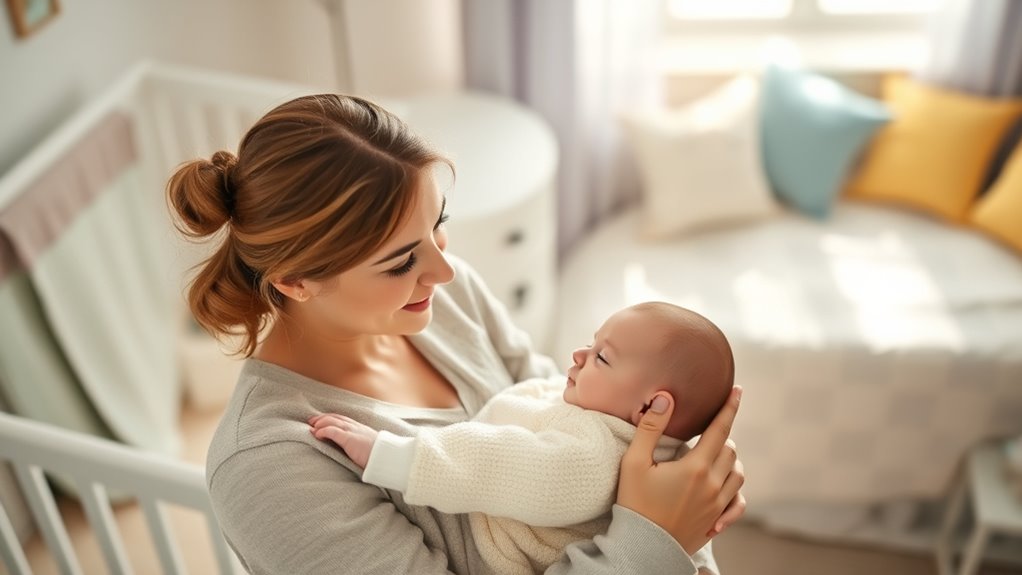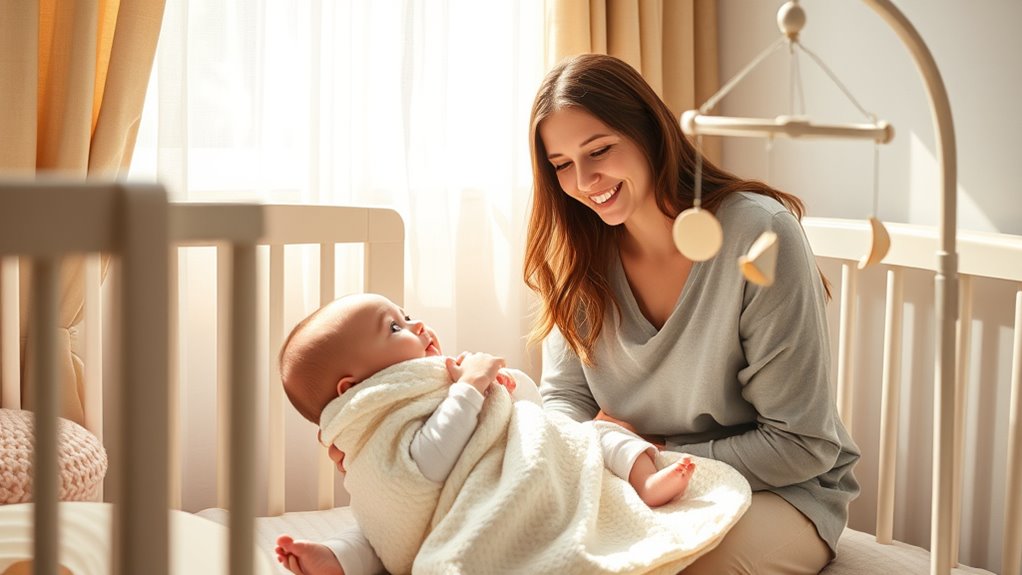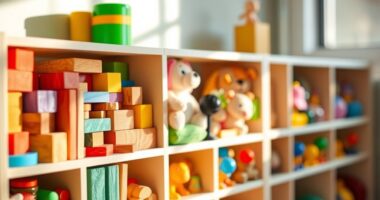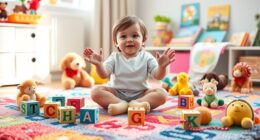To handle your baby’s separation anxiety, start by fostering a secure attachment through cuddling and comfort. Practice brief separations to help them understand you’ll return. Maintain a consistent routine to provide reassurance, and introduce new caregivers gradually. When saying goodbye, do it explicitly and keep it brief. At night, establish a calming bedtime routine and comfort them without letting them leave the bed. There are more effective strategies you can explore to ease their anxiety.
Key Takeaways
- Foster a secure attachment by providing comfort and cuddling to help alleviate anxiety.
- Practice short separations to help your baby learn that you’ll always return.
- Maintain a consistent daily routine to provide reassurance and stability for your baby.
- Use clear and brief goodbyes, avoiding sneaking away to build trust.
- Introduce transitional objects, like a favorite blanket, for comfort during separations.

As your baby grows and develops, you might notice signs of separation anxiety emerging, especially between 8 and 18 months. This is a normal stage where your little one starts to understand object permanence, realizing that things continue to exist even when they can’t see them. As this awareness develops, they may feel anxious when you leave, which can be triggered by new environments, caregivers, or significant life changes.
Though separation anxiety can start as early as 4-5 months, it often peaks around 9 months and typically resolves by age 3. You’ll recognize separation anxiety through crying when you leave the room, clinging to you in unfamiliar situations, or even showing fear of strangers. Nighttime can be particularly challenging; your baby may wake up crying for you or refuse to sleep without you nearby. These reactions stem from a lack of understanding about time and the fear that you mightn’t return. Stress or anxiety you may feel can also be picked up by your baby, exacerbating the situation.
Separation anxiety peaks around 9 months, often manifesting as crying or clinging, particularly at night.
Managing separation anxiety effectively involves fostering a secure attachment through regular cuddling and comfort. Practicing short separations can help your baby understand that you always come back. Keeping a consistent routine provides reassurance, making transitions easier. When introducing new caregivers, do it gradually to reduce anxiety and consider using transitional objects like a favorite blanket to ease those separations.
When it’s time to say goodbye, it’s best to do so explicitly instead of sneaking away. Keep your goodbyes brief yet reassuring to help lower distress. Leaving behind a familiar object can also provide comfort to your baby during your time apart. Make sure they’re well-rested before separation, as a tired baby is often more anxious. Maintaining a calm demeanor during goodbyes can help set a positive tone.
Nighttime may be particularly tough due to prolonged separations, so comforting your baby without allowing them to leave their bed is essential. Establishing a consistent bedtime routine helps signal that it’s time to sleep. Avoid introducing new sleep associations that could complicate matters. Gradually increasing your baby’s independence at night can also help manage their anxiety.
Most children outgrow separation anxiety by age 3, but if it becomes severe, seeking professional help may be necessary. Cognitive-behavioral therapy and parent training can provide support, ensuring both you and your child navigate this developmental phase smoothly.
Frequently Asked Questions
What Are the Signs of Separation Anxiety in Babies?
You might notice several signs of separation anxiety in your baby. Crying when you leave the room is common, along with increased clinginess, especially around strangers.
Your little one may wake more often at night, feeling anxious about being apart. They might also refuse to sleep without you nearby and could throw tantrums when left with caregivers they don’t prefer.
Recognizing these behaviors can help you understand your baby’s emotional needs.
At What Age Does Separation Anxiety Typically Begin?
Separation anxiety typically begins around 4-5 months and often peaks between 7-9 months.
At this stage, you’ll notice your baby becoming more clingy, especially as they develop object permanence—the understanding that things still exist even when they can’t see them.
This phase is crucial for their development, signaling a healthy attachment.
Keep in mind that every child is different, so the timing might vary based on their unique milestones and temperament.
Can Separation Anxiety Affect Sleep Patterns?
Imagine a tiny alarm clock that goes off every time you leave the room—this is what separation anxiety can feel like for your baby at bedtime.
Yes, it can definitely affect sleep patterns. You might notice more night wakings, early morning rises, and disrupted naps.
Your little one may cling to you, resisting sleep without your comforting presence. Establishing consistent bedtime routines and providing reassurance can help ease this challenging phase.
How Long Does Separation Anxiety Usually Last?
Separation anxiety usually lasts several weeks, peaking between 9 to 18 months.
It often starts around 9 months as babies grasp object permanence. While the peak distress might pass quickly, the overall phase can extend until they’re about 3 years old.
Factors like your consistency in routines and gradual exposure to new caregivers can help influence its duration.
Every child is different, so be patient as they navigate this stage of development.
Are Some Babies More Prone to Separation Anxiety Than Others?
You might wonder if some babies are more prone to separation anxiety than others, and the truth is, they can be.
Factors like temperament, developmental stage, and past experiences play a role. For instance, a baby with an inhibited temperament may cling more during separations.
Environmental changes or stressful events can also heighten anxiety levels.
Understanding these factors can help you better support your baby through their emotional challenges as they grow.
Conclusion
In conclusion, handling your baby’s separation anxiety isn’t just about comforting them; it’s also about understanding that this phase is a natural part of their development. Research shows that separation anxiety can actually strengthen the bond between you and your little one, as they learn to trust your presence even when you’re apart. So, embrace this challenging time, knowing it’s a sign of their growing attachment and emotional development. With patience and reassurance, you both will get through it together.









